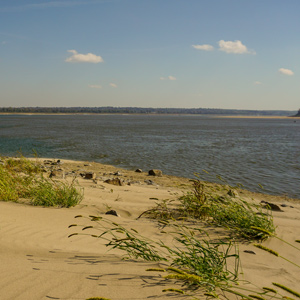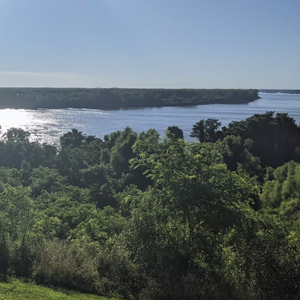History
Indian of the Nation of Shawanoe
Georges Henri Victor Collot (1750–1805)[1]Collot, Georges-Henri-Victor. Voyage dans l’Amérique Septentrionale (Paris: A. Bertrand, 1826).
Courtesy U.S. Library of Congress.
In 1648, the French called them Ouchaouanag, similar to the Shawnee /ša:wanwa/ meaning ‘people of the south’. Before that time, they may have been part of the Fort Ancient complex, a mound-building, pre-contact culture living along the Ohio River valley. The people moved extensively throughout the present-day Eastern, Southern, and lower mid-west United States. This Algonquian-speaking people combined hunting and agriculture, gathered some of their food, and after European contact, were heavily influenced by the fur trade.[2]Charles Callender, Handbook of North American Indians: Northeast Vol. 15, Bruce G. Trigger, Ed. (Washington, D.C.: Smithsonian Institution, 1978), 622–24, 634.
On 2 September 1803, Lewis and the barge (called the ‘boat’ or ‘barge’ but never the ‘keelboat’) passed one of several places on the Ohio significant in the history of the Shawnee. Logstown, now part of Pittsburgh, was previously settled by Shawnees where they grew large fields of corn. Logstown would be the location of intertribal settlements and councils as well as European-based trading posts and military forts.[3]“Logstown,” Wikipedia, accessed on 10 December 2020, https://en.wikipedia.org/wiki/Logstown; “Native Americans of the Eastern Ohio Country,” Brookline Connection, accessed 10 … Continue reading
On 19 September 1803, the day Lewis stopped writing his Ohio River journal, he likely passed the mouth of the Kenawha River, site of a Shawnee village and the place Colonel Andrew Lewis established Camp Point Pleasant after his 1774 battle victory in Lord Dunmore’s war. In that war, a different Shawnee town was destroyed. The people made peace and agreed to stay north of the Ohio River.[4]Callender, 631; “Point Pleasant, West Virginia,” Wikipedia, accessed 21 December 2020, https://en.wikipedia.org/wiki/Point_Pleasant,_West_Virginia.
On 28 September 1803, Lewis reached the area of Fort Washington, now part of Cincinnati proper but prior to the expedition, the main launching point for military campaigns in the Northwest Indian War fought against the Shawnee and their allies. Perhaps he thought about his own participation in that war and meeting William Clark.[5]Read more at https://en.wikipedia.org/wiki/Fort_Washington_(Ohio) and https://en.wikipedia.org/wiki/Northwest_Indian_War, both accessed last on 22 December 2020.
Sometime around 5 November 1803, the captains stopped or passed by Old Shawnee Town. That town and Chillicothe had previously served as the capital of the Shawnee nation.[6]Callender, 625–26.
Apple Creek Settlements
As soon as the expedition boats arrived at the Mississippi River, the captains began counting Shawnee people. These people had for generations avoided advances from Iroquois, English, and American settlement. Now, they were living with the Lenape Delawares on both sides of the Mississippi. The captains’ “Estimate of the Eastern Indians” reports that 600 “Shawonies” were living on the “apple River near Cape Gerardeau.”[7]Moulton, 3:446. The American presence must have alarmed many.
One immigrant from the District of Cape Girardeau with Shawnee lineage was the expedition’s lead hunter and interpreter George Drouillard. He had migrated to Missouri with his Shawnee mother several years prior.[8]M. O. Skarsten, George Drouillard: Hunter and Interpreter for Lewis and Clark and Fur Trader, 1807–1810 (Lincoln, NE: University of Nebraska Press, 1964), 18,20.
Tecumseh and Tenskwatawa
The Shawnee are associated with Tecumseh and his brother Tenskwatawa—formally Lalawethika, the Shawnee Prophet. The year before the expedition ended, the two brothers became rising stars among their people and eventually became popular icons of Native American courage and defiance. After the two brother’s storied history had nearly played out—Tecumseh was killed in the War of 1812 and The Prophet was exiled in Canada—Tankwatawa and William Clark crossed paths during the 1826 removal of the Shawnee from Ohio to Kansas. During the Removal Period, one large group surprised Clark, the Superintendent of Indian Affairs, by their arrival at the Mississippi. His appeals to fund the tribe were denied by the War Department and Congress.[9]Callender, 631–32; Jessica Diemer-Eaton, The First Peoples of Ohio & Indiana: Native American History Resource Book (Woodland Indian Educational Programs, 2014), 187,194–195.
Honoring Spanish Land Grants
With the transfer of Upper Louisiana to the United States completed on 10 March 1804, the land grants given to the Shawnee by the Spanish in 1793 now became questionable. Indeed, land grants would be a contentious issue for Indians and settlers alike in the upper Louisiana Territory.
The land grants would become a valuable asset for the Shawnee during negotiations in the early 1800s. In 1815, the Shawnee and Delaware from the Apple Creek settlements north of Cape Girardeau complained to General William Clark, Governor Ninain Edwards, and Colonel Chouteau that American settlers were stealing their horses and other things.[10]Harvey, History of the Shawnee Indians, 162 in Houck, A History of Missouri from the Earliest Explorations and Settlements Until the Admission of the State into the Union (Chicago: R. R. Donnelley … Continue reading During the exchange, Chief Wahepelathy, mentions his people’s land grants and good conduct and his reason for moving away:
When the Spaniards told us to choose a piece of land, and when we made choice of it, we obtained from them a grant which has since been recorded by the board of commissioners, and we understand that all the concessions granted to the white people by the Spaniards were good. We live among the white people, and our behavior has been such that no honest white man can have any cause to find fault with us; and we are certain they never will have cause to complain. We have always conducted ourselves honestly and intend to continue so. Early in the spring, on my return from hunting, I found my house had been broken open and what I had left in it all gone. I then took the resolution of moving to another place on Castor river to settle myself, provided my father, General Clark, would be pleased with my doing so.[11]American State Papers, Indians, p. 11 in Houck, 1:220.
Movement to Reservations
By 1825, most Shawnee and Delaware ceded their Missouri lands for reservation land in Kansas—a fourteen-square-mile tract on the Kansas River[12]Harvey, 184 in Houck, 1:219; Moulton, 2:90n2.
The Apple Creek Shawnee would become the nucleus of the Absentee Shawnee—so named when they refused to move to reservation lands. The Absentee Shawnee did eventually move to a reservation in Oklahoma where they preserved some of the Shawnee tradition such as the War Dance and Bread Dances.[13]Callender, 632–33.
Today, there are three Federally recognized tribes, all headquartered in Oklahoma: Absentee-Shawnee Tribe, Eastern Shawnee Tribe, and Shawnee Tribe.
Selected Pages and Encounters
George Drouillard
Hunter and interpreter, (1773–1810)
by Barbara Fifer, Joseph A. Mussulman
Drouillard was one of the captains’ three most valuable hands. He was also the highest paid member after the captains, he shared the Charbonneaus’ tent with the family and the captains, and he was the only man Clark seemed to call by first name in the journals.
August 9, 1803
Ohio River Tribal Nations

Lewis waits in Pittsburgh for the military barge to be completed. In the meanwhile, François André Michaux describes the area’s safety from Indian attacks and Shawnee Chief Black Hoof’s life is examined.
September 2, 1803
Logstown frustrations

The Ohio River around Logstown presents a day of challenges navigating through shallow water. Lewis complains about the high price residents charge to drag the barge over the ‘riffles’ with their oxen.
September 13, 1803
Marietta, Ohio

At sunrise, the boats move down the Ohio River. They lift the barge over a few riffles and see a flock of passenger pigeons. Anchored opposite Marietta, Ohio, Lewis writes a letter to President Jefferson.
September 19, 1803
Point Pleasant

From Thomas Rodney’s journal and Zadok Cramer’s 1802 river guide, we can reasonably assume that Lewis reached, or was near, Point Pleasant, West Virginia and Gallipolis, Ohio on this day.
November 16, 1803
Seaman not for sale

At the mouth of the Ohio, Lewis and Clark scout the western shore of the Mississippi River where a Shawnee man tries to buy Lewis’s dog, Seaman. In Washington City, President Jefferson plans more expeditions.
November 18, 1803
Clark's Fort Jefferson

The captains and eight men cross the Ohio to visit Fort Jefferson, established by William’s older brother, George Rogers Clark. They return to find that several enlisted men have left camp and are drunk.
November 22, 1803
The Tywappity settlements

Moving up the Mississippi, the expedition passes Tywappity Bottom—an American settlement on the Spanish side of the river. They meet two boats from Louisville also bound for Kaskaskia.
November 23, 1803
Louis Lorimier of Cape Girardeau

After arriving at Cape Girardeau, Lewis takes letters of introduction to Louis Lorimier, whose store was burned to the ground by William Clark’s brother—George Rogers Clark—in 1782.
Notes
| ↑1 | Collot, Georges-Henri-Victor. Voyage dans l’Amérique Septentrionale (Paris: A. Bertrand, 1826). |
|---|---|
| ↑2 | Charles Callender, Handbook of North American Indians: Northeast Vol. 15, Bruce G. Trigger, Ed. (Washington, D.C.: Smithsonian Institution, 1978), 622–24, 634. |
| ↑3 | “Logstown,” Wikipedia, accessed on 10 December 2020, https://en.wikipedia.org/wiki/Logstown; “Native Americans of the Eastern Ohio Country,” Brookline Connection, accessed 10 December 2020, http://www.brooklineconnection.com/history/Facts/Indians.html. |
| ↑4 | Callender, 631; “Point Pleasant, West Virginia,” Wikipedia, accessed 21 December 2020, https://en.wikipedia.org/wiki/Point_Pleasant,_West_Virginia. |
| ↑5 | Read more at https://en.wikipedia.org/wiki/Fort_Washington_(Ohio) and https://en.wikipedia.org/wiki/Northwest_Indian_War, both accessed last on 22 December 2020. |
| ↑6 | Callender, 625–26. |
| ↑7 | Moulton, 3:446. |
| ↑8 | M. O. Skarsten, George Drouillard: Hunter and Interpreter for Lewis and Clark and Fur Trader, 1807–1810 (Lincoln, NE: University of Nebraska Press, 1964), 18,20. |
| ↑9 | Callender, 631–32; Jessica Diemer-Eaton, The First Peoples of Ohio & Indiana: Native American History Resource Book (Woodland Indian Educational Programs, 2014), 187,194–195. |
| ↑10 | Harvey, History of the Shawnee Indians, 162 in Houck, A History of Missouri from the Earliest Explorations and Settlements Until the Admission of the State into the Union (Chicago: R. R. Donnelley & Sons Company, 1908), 1:219. |
| ↑11 | American State Papers, Indians, p. 11 in Houck, 1:220. |
| ↑12 | Harvey, 184 in Houck, 1:219; Moulton, 2:90n2. |
| ↑13 | Callender, 632–33. |
Experience the Lewis and Clark Trail
The Lewis and Clark Trail Experience—our sister site at lewisandclark.travel—connects the world to people and places on the Lewis and Clark Trail.
Discover More
- The Lewis and Clark Expedition: Day by Day by Gary E. Moulton (University of Nebraska Press, 2018). The story in prose, 14 May 1804–23 September 1806.
- The Lewis and Clark Journals: An American Epic of Discovery (abridged) by Gary E. Moulton (University of Nebraska Press, 2003). Selected journal excerpts, 14 May 1804–23 September 1806.
- The Lewis and Clark Journals. by Gary E. Moulton (University of Nebraska Press, 1983–2001). The complete story in 13 volumes.


